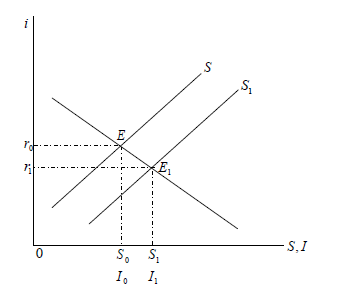An increase in savings at every level of interest leads to the savings curve in the capital market to shift down to the right from S to as show in the figure below, producing an excess supply of capital funds.

-Given that interest rate is flexible, excess supply of capital funds would put pressure on the financial institutions to lower their interest rates.
-Equilibrium interest rate would declinefrom r
0 to r
1-Lower interest rate induces increases in flow of investment in capital goods.
-Since there had been a larger flow of savings in the economy, there would be decrease in the consumption of consumer goods.
-Note: the increase in the investment in capital goods (shown as +change in I ) would be just matched by the decline in spending on consumer goods ( -change C)
-The final result is that while output has been redistributed away from consumer goods industries and towards capital goods industries, total output has not changed and the economy is still at full employment.
sharon kalunda answered the question on
April 11, 2019 at 09:59